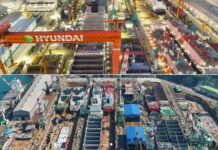
Following the impact of the Houthi attacks on commercial shipping in general and container ships in particular the number of large boxships idled fell to zero with carriers deploying tonnage to maintain schedules on the longer Cape route.
Diversions around the Cape of Good Hope began in December as the Houthi Movement fired on Israeli-bound, US and British connected vessels and Alphaliner reports that the rush to fulfil exports before Chinese New Year, these week long celebrations begin tomorrow.
All ships larger than 12,500 TEUs are now deployed “following the reactivation of two ultra-large container ships to service over the past fortnight,” reported Alphaliner, after its latest survey completed on 29 January.
Idled capacity has reached a 19-month low, at 89 ships of 226,051 TEUs, and the idled figure may have fallen even further in the last week with the latest figure from Linerlytica showing just 78 non-operational ships totalling 125,425 TEUs, 0.4% of the fleet.
“Additionally, a significant amount of capacity was reactivated from drydock to further accommodate the ‘inflated’ demand for shipping capacity during this period,” added Alphaliner.
In total 21 ships of 178,751 TEUs exited drydock and returned to operational service, total capacity now in drydock is at its lowest since March 2021, at 313,031 TEUs.
“Carriers are starting to redesign their networks to incorporate the diversion via Africa, together with the expected skipped sailings in the slack period after Chinese New Year and the arrival of many large newbuildings, this situation of tight tonnage supply might change in the coming months,” said Alphaliner.
A fact that Linerlytica can confirm with its latest report signalling a further 43 ships delivered in the last 30 days, totalling 303,601 TEUs.
The combined statistics also reveal an expected surge of capacity on the Asia to Europe trades of 23.3%, when compared to last year’s deployment, reaching an all-time high of 6.44 million TEUs.
This rush to deploy capacity is entirely a result of the diversion from the Suez to the Cape route since December 2023.
“Over 700,000 TEUs of additional capacity has been added to the trade in the last two months alone. 55% of the additional capacity has been absorbed in the Far East-Mediterranean trades where transit times have increased by 10 days to the West Med and 18 days to the East Med while transit times to North Europe has increased by seven days on average,” said Linerlytica’s analysis.
Perhaps less expected has been the increase in demand for intra-Europe capacity created by the Red Sea crisis.
“Capacity has increased by 24.8% [on intra-European trades] year-on-year, with the largest increases seen on the intra-Med and North Europe-Med routes,” reported the Hong Kong-based consultancy.
Mary Ann Evans
Correspondent at Large





